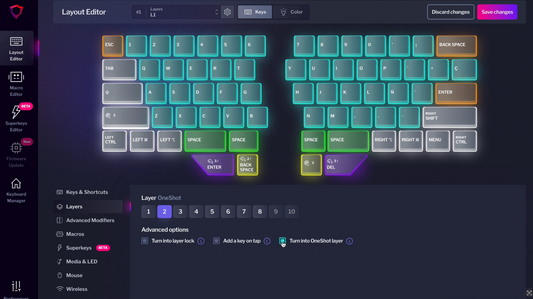Our Product Manager, Manel, and CTO, Matt, will be flying to Shenzhen tomorrow to meet with our manufacturing partners. We mentioned in our last update that this trip is a crucial time for the Raise development.
These are the things they wish to achieve during their trip:
- Have all the tooling contracts finalised and signed.
- Check all the components to make sure everything fits.
- Check the PCBs to make sure everything is working.
- Do the EMC (Electromagnetic Compatibility) Pretest.
- Create a planning schedule or a Gantt chart, so we can have a precise estimation of the shipment of the Raise.
While the guys are in China, they’ve left us with a few things that need your feedback:
- The configurator software.
- The keycap artwork for some of the languages.
MVP Raise Configurator Software
We know that many of you have been wanting to see the configurator, and the reason we haven’t shown anything is that we’ve been busy getting all the hardware ready for the Golden Prototype and the start of the assembly.
But now we have more time to work on the configurator.
What we have at hand is a MVP or a minimum viable product. The reason for doing that is because we want you to be part of the configurator development. We want your feedback to know what we can do to make it better.
We did have a functional configurator in the beginning, but it wasn’t user-friendly. With this MVP, we are aiming for it to be easy-to-use and visually receptive.
We will also contract an external UI expert, and with all of your feedback combined, we will apply that to make the configurator that ships with the Raise keyboard.
In the video below, Matt explains the layout of the wireframe. It is still basic and not functional. But this is because we want to get the right design for all functionalities first. In order to do that, we need to get your feedback!
The ABS and PBT keycaps of the Raise
With the Raise keyboard, we offer two different kinds of keycaps: ABS laser-etched keycaps and PBT double injection keycaps.
What are the differences?
In terms of their appearance, ABS keycaps are smoother and shinier, while PBT keycaps are not shiny and have a bit of texture.
How are they made?
ABS keycaps are made by a single-injection of translucent material, ABS (Acrylonitrile Butadiene Styrene) material. Then they are painted in a black color or white color. After that, they are laser-etched with the legend.
PBT keycaps are made by a double-injection process. In this process, there are two molds. One mold is injected with PBT (Polybutylene Terephthalate), which is the opaque part of the keycap. This piece is then moved to another mold and injected with a translucent material, which is a combination of ABS and polycarbonate (PC).

What are the advantages of each one?

With ABS laser-etched keycaps, the backlight is more intense because of the translucent material. These keycaps are also cheaper to produce. This means it’s great for creating small batches of multiple languages without having to create a mold (which is very expensive). This is the most common keycap used in gaming keyboards so you can find them everywhere.
The PBT double-injection keycaps are of higher quality and are more long-lasting because it is made of two different materials. It does not wear easily. It has a ‘rough’ texture and some people prefer this.
What are the disadvantages?
After constant use, the paint in ABS keycaps begins to shine. They wear faster than PBT.
As for PBT keycaps, they are harder to produce because the materials and mold used to make them are extremely expensive. It’s hard to find languages, other than English, with this material.
The artwork of each language
We offer 5 different languages in ABS laser-etched keycaps: Spanish, French, German, Japanese, and Nordic. For these keycaps, we chose the font, the size, and the design.
What we really wanted for our artwork is to have big letters so that light can become more evident. When we received the golden sample, we quickly realized that the symbols positioned at the lower part of the keycaps did not emit as much light. This is because our LEDs are located at the top of the switch.

We then reworked the artwork and placed all lower symbols to the first row of the keycap.
This is where we need your feedback. We had to adapt some of the keycap languages to the split design of the Raise and we would like your opinion on the artwork we’ve done, especially for the Nordic and Japanese keycaps.
Note: the 2 keys on the top right are extra keys.





For the PBT keycaps, it was a different story. Since the mold for PBT keycaps is expensive, we just had to look for different double-injection PBT keycap suppliers and check their products. In our last trip to Shenzhen, we were able to see different samples and decided the one we liked best.
Our PBT keycaps are the US English and UK English keycaps, which are included with the Raise by default.


The special keycaps
Apart from the off-the-shelf keycaps, we have 8 special keycaps for the thumb, and also two special keycaps with the Dygma logo. These keycaps will be made with a 10-cavity mold. With this mold, we will be creating both PBT and ABS keycaps.
That’s all for the keycaps!
Your feedback needed
We hope that you find all this information interesting! Again, we would greatly appreciate your feedback on the configurator software and our artwork so please leave a message on the comments below.
Thank you again for all of your support. You all have played a big part in the Raise development!
- Dygma Team









